Known as “the smoke that thunders”, the falls at the Zambian side are a must-see. It’s a spectacle of nature! In today’s post, I will share everything you need to know to visit Victoria Falls in Zambia.
The Zambezi River forms the Victoria Falls on the border of Zambia with Zimbabwe and is one of the most beautiful falls in the world, among the 7 Natural Wonders of the planet and patrimony of the Humanity by Unesco since 1989. The falls have an average 120m of height and almost 1,7km of extension.
Although the falls had already been registed by Nicolas de Fer in 1715, David Livingstone was recognized as the first Westerner to see it in 1855. Victoria Falls was given the name by him in honor of the queen and the name the locals gave is Mosi- a-tunya, which means ‘smoke that thunders’ because of the steam rising from the fall. Mosi-oa-tunya is also the name of the Zambian National Park harboring the fall.
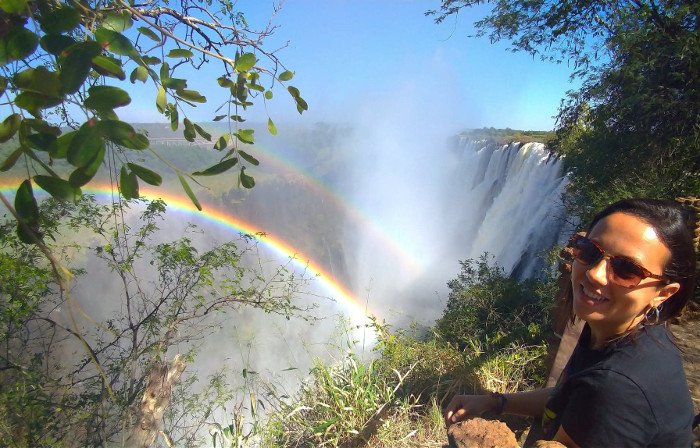
# About getting wet
You will get completely wet (if you do not use a raincoat). When I crossed the bridge linking Zimbabwe to Zambia, I already felt the spills, so it is true that on the park bridge, Knife-Edge, which is a few meters from the falls, the volume of water that condenses and falls is huge. It’s like you’re going under the shower.
Footwear: I wore a waterproof boot. What did it do? Nothing! Water flows down the leg and enters the footwear (even when wearing a raincoat the feet get soaked). So I suggest you use plastic shoes. If you feel insecure with slippers or have physical limitations to move around, I recommend crocs and sandals.
The raincoat is effective to prevent you from wetting the body and protecting the electronic equipment, but to manipulate them to take pictures it is also ideal to use an umbrella to avoid the water drops on the lenses. If you do not have, or forgot, the raincoat or footwear, it’s possible to rent crocs and covers for 2 dollars inside the park.

I went to the falls with a Tongabezi guide (the lodge that I stayed at when I visited), he provided a raincoat and umbrella). He was very attentive and helped me when I needed to take pictures, he did open the umbrella and hold it above the camera so it would not get wet.
I noticed that people who did not use anything to protect themselves from the water were more connected with the place, so if you are willing, surrender! You can see the “smoke” of the falls in an area of up to 30km around the park. It is, as I said, a great work of nature.
All unsafe edges are bordered by well-structured fences. The wooden bars supported by columns of stone and concrete are resistant, but because they are constantly wet they are slippery, making it unsafe to climb or lean on them to take pictures.
The banks of the river before the fall can also be visited. There is no such barrier, but the trail is well defined and made of concrete. Anyone who goes beyond the demarcated limit does so consciously. In addition to warning signs about staying on the trail, pointed stones were placed separating the trail from the river bank. It is important to respect the signage, several people have already fallen in the river and you will see that if you fall there is no coming back.

# Best month to visit
The highest volume of water is between March and May, but the high season runs from February to July. Between August and January, the volume of water is low and therefore, it is the best time for rafting. During this time it is possible to descend the trail to the Boiling Pot – a huge whirlpool at the base of the waterfall.
If adventure is your goal, then look for Devil’s Pool , a natural swimming pool accessible by Zambia, within 100m of the waterfall. The tour takes half a day and is done with a guide in the dry season for an average of 160 dollars with an inclusive meal. A boat departs from the Royal Livingstone Hotel in Zambia to Livingstone Island where a guided hike takes place and then to the Devil’s Pool.
There is also the possibility to take the helicopter or microlight tour that costs around 160 dollars and lasts 15 minutes to an hour. Regarding adventures, there is also the possibility to jump from a bungee jump off the old bridge that connects the two countries. Unfortunately, I went in April and could not do the Devil’s Pool.
Another cool activity is the “lunar rainbow” or nocturnal rainbow. They say it’s an amazing thing to do and that can be seen on the 3 full moon nights. The best months to see the rainbow are from April to September.

# Victoria Falls – Time to visit
People usually stay for about an hour at the falls. The path of little more than 1km is quite light and accessible, but my suggestion is to schedule to stay longer to really enjoy the environment. I stayed there for 2 hours because I went with the guide and he was telling us several stories, including David Livingstone’s history.
You are likely to see animals such as wild warthog, baboons, Chlorocebus, bushbucks, and many birds. By respecting their space and paying attention to your food, you do not have to worry, just enjoy the pleasure of observing them.
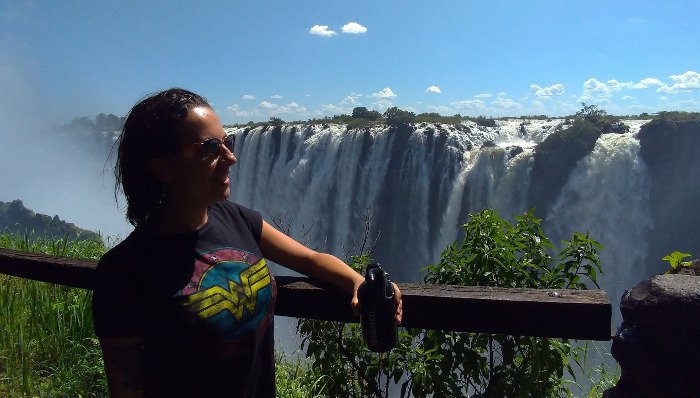
# Maramba Market
In front of the Mosi-oa-tunya park is the Maramba Market. I decided to buy the souvenirs all at once and it was good to negotiate a fair price. In addition, it felt good to know that I was collaborating with the local community that does the crafts.
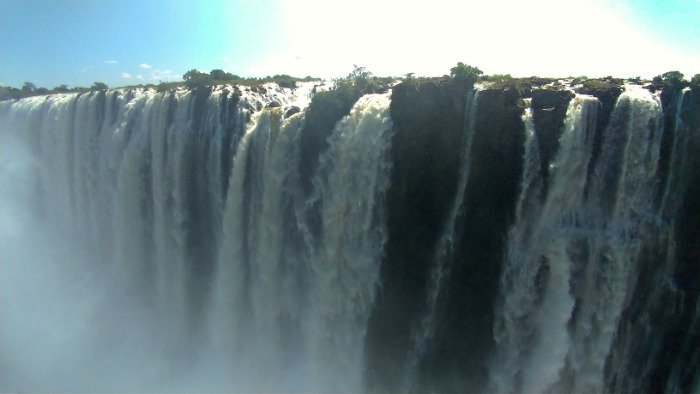
# Victoria Falls at the Zambian side vs. Vic Falls at the Zimbabwe side
First I visited the falls on the Zim side and found it cool, but when I visited the falls at the Zambian side I found it very cool. At Mosi-oa-tunya you can get closer to the waterfalls. The excitement is greater, especially if you embrace getting wet!
At the Zimbabwean side, infrastructure is better and the park area is larger. There it is the chance to get less wet, I did not even go with a raincoat, I caught a kind of heavy fog.
My advice is: visit both sides and form your own opinion.

# Useful information
Entrance fee = 20 dollars for foreigners. Children under 6 years do not pay.
Hours of operation = from 6 a.m. to 6 p.m., daily.
The use of drones is prohibited.
# Victoria Falls – Where to stay
I stayed at TONGABEZI in Livingstone. Without a doubt, it is the best option for those who want to go to the Falls on the Zambian side and also relax and enjoy the best that the region has to offer.

Tongabezi is an exclusive lodge with impeccable service. It has only 9 accommodations (being 4 River Cottages and 5 Houses), I stayed 1 night at one of the River Cottages and 1 night at the “Nut House” , I simply loved every minute of my time there! The lodge offers accommodation, meals and several complementary activities.
The guided tour to the falls is one of the complementary activities. Just schedule the time that you want to go. Theguide, besides taking you there, will accompany you throughout the course in the park.
Note: the ticket is not included.
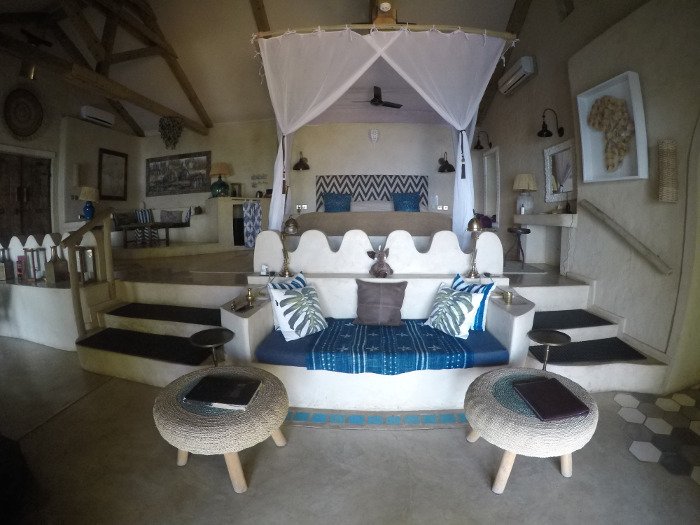
# Travel Consulting
The consultancy aims to give you freedom and security, but at the same time save time and money. I can plan ALL your trip (airplane tickets, accommodation, day by day itinerary) according to your budget and objectives. For more details send me an email ( contato@partiuviajar.blog.br )
So, have you ever visited Victoria Falls in Zambia? Enjoyed it? I hope you enjoyed the post. Oh, I wrote the post “What to do in Zambia: everything you need to know to travel to the country” in which I speak about visa, currency, language and general information about Zambia, check it out!
To see more pictures of my trip through Africa (Zambia, Zimbabwe, Botswana and South Africa) take a look at our Instagram @partiuviajarblog.
See you!
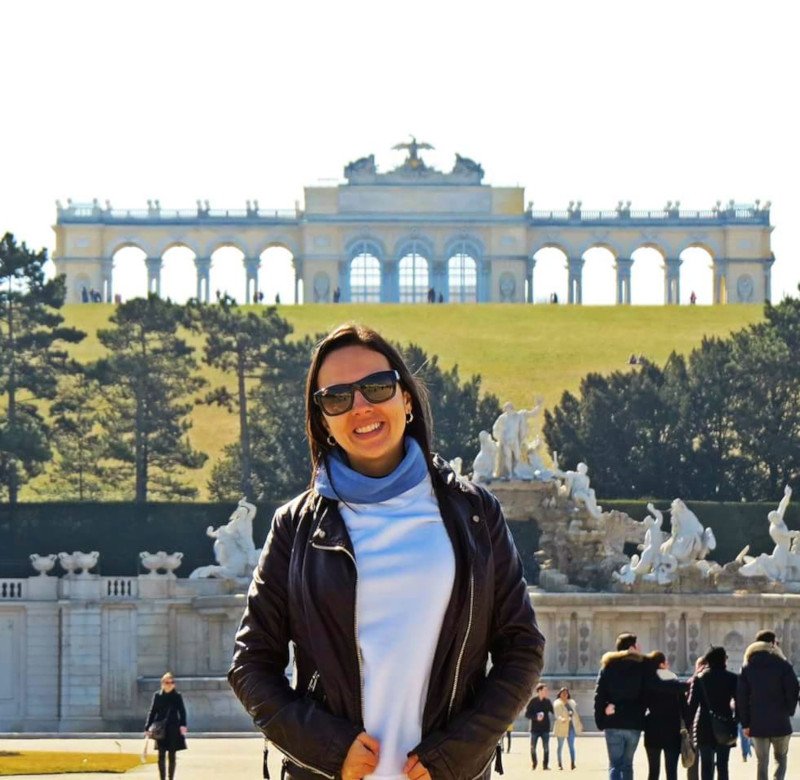
Nasci e cresci no interior de Minas Gerais, sou advogada de formação e consultora de viagens de profissão. Tenho 33 anos e desde sempre sonho em viajar o mundo. Já visitei 37 países (alguns mais de uma vez), tendo morado em 4 deles. Em 2016 criei o blog Partiu Viajar para ajudar e inspirar mais pessoas a viajar.

